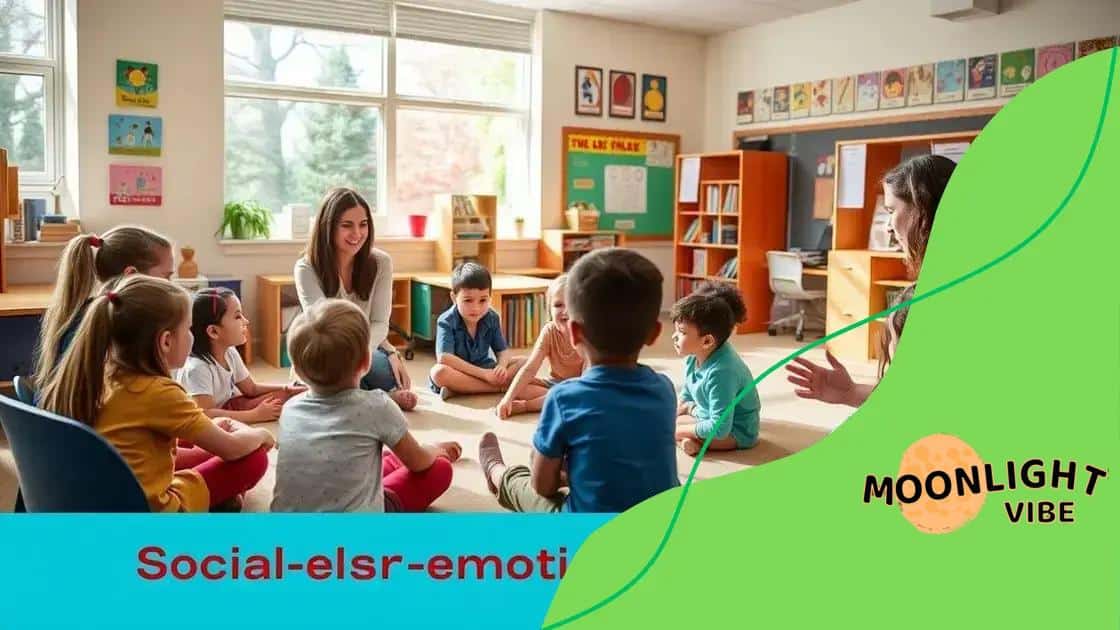Integrating social-emotional learning in school curricula

Anúncios
Integrating social-emotional learning (SEL) in school curricula enhances students’ emotional intelligence, improves academic performance, and fosters better relationships by creating a supportive learning environment that involves families and the community.
Integrating social-emotional learning in school curricula can transform student experiences, fostering skills like empathy and collaboration. Have you ever wondered how these skills affect not just academics, but overall life success? Let’s dive into why SEL is becoming essential in today’s education.
Anúncios
Understanding social-emotional learning
Understanding social-emotional learning is fundamental for creating a supportive classroom environment. It involves teaching students essential skills like emotional regulation, empathy, and effective communication. These skills not only enhance academic performance but also prepare students for life’s challenges.
What is Social-Emotional Learning?
Social-emotional learning (SEL) encompasses the process through which children and adults learn to understand and manage emotions. It also involves developing positive relationships and making responsible decisions. When we integrate SEL into education, we help students become more self-aware and socially adept.
Key Components of SEL
- Self-awareness: Recognizing one’s emotions and their impact on behavior.
- Self-management: Developing skills to control one’s emotions and impulses.
- Social awareness: Understanding and empathizing with others and their perspectives.
- Relationship skills: Building and maintaining healthy relationships through communication and teamwork.
- Responsible decision-making: Making constructive choices about personal and social behavior.
Integrating these components into daily lessons can create a more cohesive learning atmosphere. Educators can witness firsthand how SEL positively affects student connections and engagement.
Anúncios
By teaching students to recognize their feelings, we prepare them for future interactions. This process starts as early as preschool and continues through high school and beyond. Educators play a crucial role in modeling and reinforcing these skills to help students thrive both inside and outside the classroom.
In essence, when students learn about their emotions and the emotions of others, they build a brighter future for themselves. Integrating social-emotional learning in school curricula helps pave the way for a more compassionate and understanding society.
Benefits of emotional intelligence in students
Understanding the benefits of emotional intelligence in students is crucial for fostering a positive learning environment. Emotional intelligence, often referred to as EQ, helps students manage emotions, demonstrate empathy, and build stronger relationships with peers. The impact of developing these skills stretches far beyond academics.
Enhanced Academic Performance
Students with high emotional intelligence tend to perform better in school. They are better at handling stress and can focus on their studies. By recognizing and managing their emotions, these students can tackle challenges and remain motivated during tough times.
Improved Social Skills
Social skills greatly benefit from emotional intelligence. Students learn to communicate effectively and resolve conflicts amicably. These abilities help in forming friendships and can lead to a more cohesive classroom environment.
- Effective communication: Students articulate their thoughts and feelings clearly, avoiding misunderstandings.
- Conflict resolution: Emotionally intelligent students find peaceful solutions to disagreements, promoting cooperation.
- Empathy: Understanding others’ emotions fosters compassion and strong friendships.
As students become more aware of their own emotions, they learn to recognize and validate the feelings of others. This awareness can create a supportive atmosphere in schools, where all students feel valued.
Furthermore, students with strong emotional intelligence often exhibit greater resilience. They can bounce back from setbacks and persist in the face of challenges. This resilience is vital in today’s fast-paced, ever-changing world. Developing emotional intelligence not only benefits students during their school years but also prepares them for adult life.
Strategies for implementing SEL in classrooms

Implementing social-emotional learning (SEL) in classrooms requires thoughtful strategies that engage students while promoting their emotional intelligence. Educators can adopt various methods to integrate SEL effectively into their teaching practices.
Creating a Safe Environment
One of the first steps is to create a safe and supportive classroom environment. Students need to feel secure to express their emotions and share their thoughts with others. Establishing clear rules and routines fosters a sense of safety and belonging.
Integrating SEL into Daily Activities
Another strategy is weaving SEL into daily activities. This can be achieved by incorporating emotional themes into lessons and discussions. For instance, during reading sessions, teachers can choose stories that highlight emotional experiences. Discussing characters’ feelings can spark conversations about identifying emotions and building empathy.
- Daily check-ins: Start each day with a brief check-in where students express how they feel.
- Role-playing: Use role-playing scenarios to illustrate emotional situations, helping students practice responses.
- Mindfulness exercises: Incorporate short mindfulness activities to help students manage stress and enhance self-awareness.
Incorporating these practices can make SEL a natural part of the school day. Students will benefit from consistent exposure to emotional learning.
Another effective approach is involving families in the SEL process. Providing resources and information to parents helps them reinforce social-emotional skills at home. When families understand the importance of SEL, they can support their children’s growth beyond the classroom.
Finally, ongoing professional development for educators is vital. Workshops and training sessions on SEL give teachers the tools they need to implement these strategies confidently. Continuous learning ensures that educators remain informed about the best practices for teaching social-emotional skills.
Engaging parents and the community in SEL
Engaging parents and the community in social-emotional learning (SEL) is essential for reinforcing the skills students learn at school. When families and community members participate, they help create a consistent message about the importance of emotional intelligence.
Building Partnerships with Parents
One effective way to engage parents is to involve them in school activities that focus on SEL. Schools can host workshops or informational sessions to educate parents about the principles of SEL. These events can help parents feel more connected to their children’s education.
Communication Strategies
Maintaining open lines of communication with parents is key. Schools can send newsletters or emails highlighting SEL topics being covered in class. Providing resources can also empower parents to discuss these concepts at home.
- Parent-teacher conferences: Use these moments to discuss students’ emotional development and share strategies families can use.
- Online resources: Create a section on the school’s website dedicated to SEL, offering articles, activities, and videos parents can access.
- Invite feedback: Encourage parents to share their thoughts and experiences regarding SEL to foster collaboration.
Involving the community is equally important. Local organizations can support schools by providing resources or leading workshops. Collaboration with community centers, mental health organizations, and local businesses can enhance the SEL initiatives within the school.
Schools can also create events where students, parents, and community members come together to participate in SEL activities. These events not only strengthen community ties but also highlight the importance of emotional learning for everyone involved.
Additionally, recognizing and celebrating SEL achievements within the school can engage parents. Hosting events such as talent shows or showcases provides opportunities for students to display their skills, making parents feel proud and involved in the learning process.
Measuring the impact of social-emotional programs
Measuring the impact of social-emotional programs is critical to understanding their effectiveness in schools. Educators and administrators need reliable methods to assess how these programs influence student behavior, academic performance, and emotional well-being.
Common Assessment Methods
One common approach is using surveys and questionnaires to gather feedback from students, parents, and teachers. These tools can help identify shifts in emotional awareness, social skills, and attitudes towards learning.
- Pre- and post-program assessments: Conduct assessments before and after the implementation of an SEL program to measure changes in students’ emotional skills.
- Observation tools: Teachers can observe students’ interactions and behaviors, noting improvements in communication and conflict resolution.
- Focus groups: Organizing discussions among students and staff can provide insights into the qualitative impact of SEL initiatives.
Additionally, standardized tests can be examined to see if there are any correlating improvements in academic performance. Schools can analyze patterns in grades, attendance, and behavioral incidents to gauge the effectiveness of their SEL programs.
Data collection should also consider external factors. Understanding the broader context, such as home environment and community support, can help clarify the effects of SEL on student development. Regularly reviewing and analyzing this data allows schools to refine their programs to better meet student needs.
Finally, sharing results with stakeholders, including parents and community members, promotes transparency and fosters continued support for social-emotional learning initiatives. This approach not only measures success but also highlights the community’s role in supporting students’ emotional growth.
social-emotional learning (SEL) into school curricula benefits students in many ways. It enhances emotional intelligence, improves academic performance, and fosters better relationships among peers. Engaging parents and the community strengthens these initiatives, providing students with a solid support network. Measuring the impact of SEL programs is essential to ensure they are meeting the needs of all students and creating a positive learning environment. By investing in SEL, we prepare students not just for school, but for life. Let’s continue to make SEL a priority for future generations!
FAQ – Frequently Asked Questions about Social-Emotional Learning (SEL)
What is social-emotional learning (SEL)?
SEL is the process of developing skills to manage emotions, set goals, show empathy, maintain positive relationships, and make responsible decisions.
How can SEL benefit students?
SEL helps improve academic performance, enhances emotional intelligence, fosters better relationships, and prepares students for real-life challenges.
What strategies can schools use to implement SEL?
Schools can create a safe environment, integrate SEL into daily activities, engage families, and provide ongoing training for educators.
How is the effectiveness of SEL programs measured?
Effectiveness is measured using surveys, observations, pre- and post-program assessments, and data analysis on academic performance and behavior.





